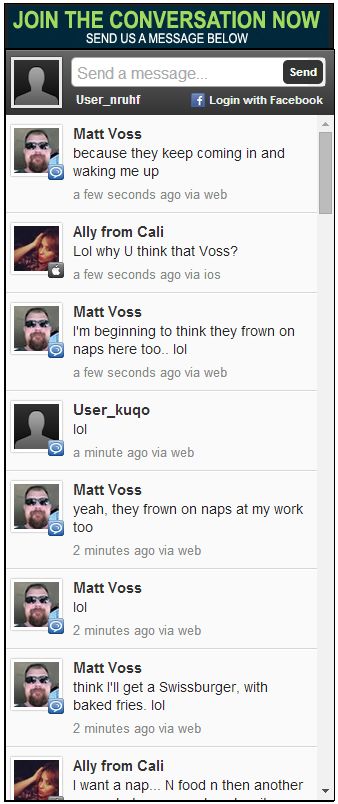 As terrestrial radio is challenged to extend its brands and experiences into the digital realm, social engagement represents an important aspect of keeping listeners involved. The Commotion social platform provides a breakthrough and (to date) unique platform for encouraging real-time conversation among listeners, while owning and shaping the experience. We spoke to CEO Ryan Burgoyne, to learn more about Commotion.
As terrestrial radio is challenged to extend its brands and experiences into the digital realm, social engagement represents an important aspect of keeping listeners involved. The Commotion social platform provides a breakthrough and (to date) unique platform for encouraging real-time conversation among listeners, while owning and shaping the experience. We spoke to CEO Ryan Burgoyne, to learn more about Commotion.
The easy way to “do social” is to outsource it — in other words, put the station on Facebook and Twitter, and try to reach listeners with posted updates. Many stations check off those social boxes, but there are two problems. First, the audience is engaged on a platform the station doesn’t own, and second, whatever social activity ensues is not in real-time.
“Real-time conversation is the key,” Ryan Burgoyne told RAIN in a phone conversation. “We describe Commotion this way: ‘Moving at the speed of radio.'”
 Commotion allows stations to host real-time chat and messaging conversations on their websites, and, crucially, in their mobile apps. In rolling out this experience, and building a list of over 200 radio stations using Commotion, Burgoyne discovered something remarkable and revealing: Users came into the sites and apps to participate in the community, even if they did not stream the webcast. As such, Commotion provides something unusual for AM/FM — a pure digital extension of an entirely new experience, which can also be tightly connected to whatever is happening on the air.
Commotion allows stations to host real-time chat and messaging conversations on their websites, and, crucially, in their mobile apps. In rolling out this experience, and building a list of over 200 radio stations using Commotion, Burgoyne discovered something remarkable and revealing: Users came into the sites and apps to participate in the community, even if they did not stream the webcast. As such, Commotion provides something unusual for AM/FM — a pure digital extension of an entirely new experience, which can also be tightly connected to whatever is happening on the air.
The importance and attraction of real-time community was not an instant revelation when Commotion started in 2008. The product started as an aggregator of Facebook and Twitter updates — that collection service brought the content onto the station website, but did not relocate the actual engagement platform to the station’s control.
“We started this when social media was taking off, Facebook was starting to get hot,” Burgoyne explained. “We found that the DJs, who wanted to interact with listeners, were moving everyone over to Facebook. DJs just wanted to engage, but in doing so on Facebook, the radio station could not control or own it.”
Commotion underwent a number of reinventions over five years. “In 2011 we made a significant shift,” Burgoyne said. “We put tools in the app that would bring listeners into the app even if they weren’t going to stream the station webcast. At that time, most people used radio apps as portable radios. We thought the mobile app should be a communication portal for the listeners.”
The result can easily be seen by visiting a client station website with a large engaged community of listeners, such as The Ranch 95.9 in Texas. Commotion has expanding footprints in the U.S., Canada, and South America. Burgoyne: “Radio wants to keep the conversation on its own properties, and users love it.”
“Real-time conversation is the key.” –Ryan Burgoyne, CEO, Commotion
Used to its greatest potential, Commotion can tightly integrate on-air events with in-app experiences, and glue the whole thing together with real-time conversation among listeners. Burgoyne described an example: “If a DJ talks about a Miley Cyrus video that just went viral two minutes ago, they’re able to jump on the air, tell their listeners to open the station app, and instantly the listeners can see the video and get into the conversation.”
The key to real-time app control is Commotion’s App Manager, which makes the station app much more fluid, changeable, and responsive to on-air events than traditional radio apps, which Burgoyne says have historically been little more than portable radios.
Ambitious stations with technology resources can custom-build community experiences for their listeners using Commotion’s API (Applecation Programming Interface).
Ryan Burgoyne doesn’t (yet) see meaningful competition for his platform. “We’re surprised it’s taking so long for somebody to catch the idea that radio should have a visual component. Nobody has tacked the real-time communication challenge. It’s expensive, and difficult to do well. Recently, TuneIn announced it wanted to be the social media for radio. We thought, ‘This is interesting!’ We looked at their app — it’s really about making comments, as you would on a station’s website.”
